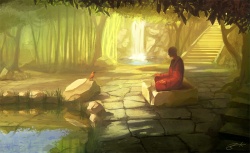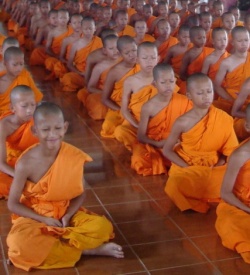Buddhism in Bangladesh by Venerable Praben Kamer Barua
Nearly one million Buddhists living in Chittagong, Chittagong Hill Tracts, Comilla, Noakhali, Cox's Bazar and Barisal in Bangladesh is said to be less than one present its total popurolation. Even though they have long history, belonging to four groups of Nations who have been gradually mixed together, which are the Austic, the Tibeto-Burman, the Draviyans and the Aryans, how their current situation is and what is their future is what all about conducted this essay.
Historical Background
According to historians the Tibeto-Burman consists of 3 tribes - the Pyu, the Kanyan and the Thet (Chakma). The Chakma tribes are living in their historical land in the Chittagong Hill Tracts. The Kanyan tribe is known as the Rakhine (Arakanese) group who still live in the South-Eastern part of Chittagong. The plain Buddhists of Bangladesh known as the Burua-Buddhist are the ancient peoples of Bangladesh who have lived here for five thousand years according to Arakanese chronology. They insist that they came from the Aryavarta or the country of the Aryans which is practically identical to the country later known as the Majjhimadesh or Madhyadesh in Pali literature.
Lord Buddha preached Buddhism during the 6th century BC in the Majjhimadesh or the Middle country which is extended in the East of the town of Kajangal, beyond which was the city of Mahasal; in the South-East to the river Salalavati (Saravati); in the South of the town of Satakannika; in the West to the Brahman district of Thuno; in the North to Usiradhaja mountain. He traveled within these boundaries on foot for the propagation of His religion. The Dhannyawadi Chronicles claim that a Buddha-image known as Maha Mrat Muni was made in the presence of Buddha Himself. Buddha is said to come to Kajangal in Tripitaka and gave two discourses to His followers there.
Although there is no record that Buddha came to any part of Bangladesh during His life to deliver any discourses, it may be assumed that the fragrance of Buddhism spread in Bangladesh during the lifetime of Buddha as we had one or two monks of Bengal who approached the Buddha to learn about His teaching. Though lack of evidence of their coming back to native land, the concept of gratitude in Buddhism can prompt someone to assume the origin of Buddhism in Bangladesh in them.
Propagation of Buddha Sasana to Bangladesh and Its Situation
The flourishing state of Buddhism in Bangladesh at the beginning of the Gupta period presupposes that Buddhism had been prospering in different parts of Bangladesh during the early centuries of the Christian era. Now it has been clear that the Buddhism in that time folllowed the Mahayana principles. Fa-hein mentioned in his itinerary (399 - 414 A.D.) about the Kingdom of Champa on the Southern bank of the Ganges when he came across much evidence of living Buddhism which was mostly Mahayana. In the 7th century, Hiuen-Tssang, the famous Chinese pilgrim in India, recorded various accounts of the persecution of Buddhism by Sasanka, the king of Gouda (North Western part of Bengal). He recorded Mahayana Buddhism in various parts of Bangladesh with some Sthavir schools. From the 7th to 12th centuries the Mahayana sect found a golden era in Bangladesh, great Buddhist monasteries in Paharpur, Somapura, Jagaddal, Vikrampur, Pattikeraha were established. Scholars like Sree Dipankar Atish, Shilabadra, Shantiraksit appeared in Bangladesh and their scholastic works were towards the Mahayana school, which ultimately absorbed Tantricism.
The Tantiric Buddhists had forgotten the original teaching of Lord Buddha. They lost the basic principles of Buddhism. Even the monks of the Buddhist community engaged in the 5 Ms (Matsya, Madya, Mithun and Mudra-Fish, Meat, Wine, Sexual intercourse, Dancing, Pose or Money). Seeing the downfall of Buddhism in Bangladesh many monks and laities tried to rectify this situation. During the 15th century (according to Dr.Heinz Bechert) one member of the Royal family named “Keyakcu” of Cakaria went to Moulmein in Burma and was ordained there under the tutelage of Ven. Sharbu. He was named Ven.
Chandrajyoti Bhikkhu and stayed for 20 years in Burma to study the scriptures. He came to Chittagong and established Asrams in Sitakunda, Haidgaon called Cakrasala, cendirpuni, thegarpuni, Chittagong, Ramu etc. For the propagation of Theravada Buddhism.But he failed to organise a traditional Buddhist Sangha in Bangladesh. The people of Bangladesh remained in darkness about Theravada Buddhism.
In 1864 Ven. Sangharaj Saramedha came to Chittagong and brought with him a full chapter of trained monks in order to give higher ordination to those who were willing. He was then staying at Pahartali Mahamuni in Chittagong. During the annual ”Mahamuni Fair” many Buddhists assembled there and on that auspicious occasion he gave higher ordination afresh to seven monks of Chittagong in the Udaka- Ukkhepa. Sima of Hancoar-Ghona near Mahamuni village. This was the first historic Upasampada ceremony in Chittagong by which Theravada Buddhism was officially inaugurated.
The Theravada-based religious reformation movement inspired the monks and people of the region. Eventually, they discarded their Tantric practices and other superstitions and the monks were given fresh ordination and initiated into the Theravada monastic disciplines. Such was the success of the reformation movement that more than 95 percent of the total number of Buddhist monks in Chittagong and Chittagong Hill Tracts and other Buddhist populated regions came under the fold of the newly reformed Theravada Buddhist Sangha. This led to the establishment of a reformed Bhikkhu Sangha popularly named as Sangharaja Nikaya.
But after the 12th century AD, Buddhism was challenged by the militant opposing forces in the sub- continent and was finally rooted out from its place of origin. At this declining time, Buddhists from Magadha (Burma) and vaisali (Bihar,India migrated to Chittagong and settled there mixing with local Buddhists. Greater Chittagong always kept the torch of Buddhism alive because it came several times under the Arakanase Buddhist kings from 2nd to 15th Century A.D.
Who were followers of Theravada Buddhism?
Bangladesh Buddhists are the original Buddhists of the country but to political economical, social and religious changes today, the vast majority of Buddhists have become a small community. At present Buddhist are living in Chittagong, Cox’s Bazar, Bandarban, Rangamati, Khagrachari, Patuakhali, Dhaka and Barguna Districts. Other than the Bengalee Buddhists, there are tribal Buddhists in Bangladesh. Among them Chakmas, Marmas, and Rakhaines are worth mentioning.
For a long time these Buddhist people are harassed and ill-treated by the governing bodies of the Country. Very recently the members of the Buddhist minority in the Cox’s Bazar area were attacked by unidentified people and those Bangladeshi Muslims burned at least 10 Buddhist Temple and 40 homes in anger over a flues photo published on Facebook. I wish to extend my sincere thanks to all who should concern at that moment.
Its Future
The Buddhists of Bangladesh are generally characterized by their spirit of sincerity, Hospitality, Charity and Trustworthiness. Twelve lakh Buddhists of Bangladesh are still maintaining their old tradition following Theravada Buddhism. Buddhists are playing an important role in the international field in forging close relationship with world Buddhists and also projecting the glorious image of Bangladesh. The Buddhists of Bangladesh through small in number in the context of country’s population is a living force working for a better future in the 21th century.
Source
Author: Venerable Praben Kamer Barua
buddhismandaustralia.com


